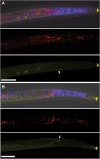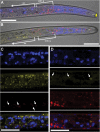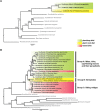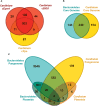Comparative Genomics of Wolbachia- Cardinium Dual Endosymbiosis in a Plant-Parasitic Nematode
- PMID: 30459726
- PMCID: PMC6232779
- DOI: 10.3389/fmicb.2018.02482
Comparative Genomics of Wolbachia- Cardinium Dual Endosymbiosis in a Plant-Parasitic Nematode
Abstract
Wolbachia and Cardinium are among the most important and widespread of all endosymbionts, occurring in nematodes and more than half of insect and arachnid species, sometimes as coinfections. These symbionts are of significant interest as potential biocontrol agents due to their abilities to cause major effects on host biology and reproduction through cytoplasmic incompatibility, sex ratio distortion, or obligate mutualism. The ecological and metabolic effects of coinfections are not well understood. This study examined a Wolbachia-Cardinium coinfection in the plant-parasitic nematode (PPN), Pratylenchus penetrans, producing the first detailed study of such a coinfection using fluorescence in situ hybridization (FISH), polymerase chain reaction (PCR), and comparative genomic analysis. Results from FISH and single-nematode PCR showed 123/127 individuals in a focal population carried Cardinium (denoted strain cPpe), and 48% were coinfected with Wolbachia strain wPpe. Both endosymbionts showed dispersed tissue distribution with highest densities in the anterior intestinal walls and gonads. Phylogenomic analyses confirmed an early place of cPpe and long distance from a sister strain in another PPN, Heterodera glycines, supporting a long history of both Cardinium and Wolbachia in PPNs. The genome of cPpe was 1.36 Mbp with 35.8% GC content, 1,131 predicted genes, 41% having no known function, and missing biotin and lipoate synthetic capacity and a plasmid present in other strains, despite having a slightly larger genome compared to other sequenced Cardinium. The larger genome revealed expansions of gene families likely involved in host-cellular interactions. More than 2% of the genes of cPpe and wPpe were identified as candidate horizontally transferred genes, with some of these from eukaryotes, including nematodes. A model of the possible Wolbachia-Cardinium interaction is proposed with possible complementation in function for pathways such as methionine and fatty acid biosynthesis and biotin transport.
Keywords: Cardinium; Pratylenchus penetrans; Wolbachia; endosymbiont; genomics; horizontal gene transfer; plant-parasitic nematode; symbiosis.
Figures











Similar articles
-
Variable Abundance and Distribution of Wolbachia and Cardinium Endosymbionts in Plant-Parasitic Nematode Field Populations.Front Microbiol. 2019 May 7;10:964. doi: 10.3389/fmicb.2019.00964. eCollection 2019. Front Microbiol. 2019. PMID: 31134014 Free PMC article.
-
Distribution of Bacterial Endosymbionts of the Cardinium Clade in Plant-Parasitic Nematodes.Int J Mol Sci. 2023 Feb 2;24(3):2905. doi: 10.3390/ijms24032905. Int J Mol Sci. 2023. PMID: 36769231 Free PMC article.
-
Genomic evidence for plant-parasitic nematodes as the earliest Wolbachia hosts.Sci Rep. 2016 Oct 13;6:34955. doi: 10.1038/srep34955. Sci Rep. 2016. PMID: 27734894 Free PMC article.
-
Endosymbionts of Plant-Parasitic Nematodes.Annu Rev Phytopathol. 2018 Aug 25;56:225-242. doi: 10.1146/annurev-phyto-080417-045824. Annu Rev Phytopathol. 2018. PMID: 30149795 Review.
-
Horizontal Transmission of Intracellular Insect Symbionts via Plants.Front Microbiol. 2017 Nov 28;8:2237. doi: 10.3389/fmicb.2017.02237. eCollection 2017. Front Microbiol. 2017. PMID: 29234308 Free PMC article. Review.
Cited by
-
Variable Abundance and Distribution of Wolbachia and Cardinium Endosymbionts in Plant-Parasitic Nematode Field Populations.Front Microbiol. 2019 May 7;10:964. doi: 10.3389/fmicb.2019.00964. eCollection 2019. Front Microbiol. 2019. PMID: 31134014 Free PMC article.
-
Unveiling metabolic integration in psyllids and their nutritional endosymbionts through comparative transcriptomics analysis.iScience. 2023 Sep 15;26(10):107930. doi: 10.1016/j.isci.2023.107930. eCollection 2023 Oct 20. iScience. 2023. PMID: 37810228 Free PMC article.
-
Essential Amino Acid Enrichment and Positive Selection Highlight Endosymbiont's Role in a Global Virus-Vectoring Pest.mSystems. 2021 Feb 2;6(1):e01048-20. doi: 10.1128/mSystems.01048-20. mSystems. 2021. PMID: 33531407 Free PMC article.
-
Wolbachia in Antarctic terrestrial invertebrates: Absent or undiscovered?Environ Microbiol Rep. 2024 Dec;16(6):e70040. doi: 10.1111/1758-2229.70040. Environ Microbiol Rep. 2024. PMID: 39533947 Free PMC article.
-
Whole genomic sequencing and sex-dependent abundance estimation of Cardinium sp., a common and hyperabundant bacterial endosymbiont of the American house dust mite, Dermatophagoides farinae.Exp Appl Acarol. 2020 Mar;80(3):363-380. doi: 10.1007/s10493-020-00475-5. Epub 2020 Feb 18. Exp Appl Acarol. 2020. PMID: 32072355
References
LinkOut - more resources
Full Text Sources
Miscellaneous

